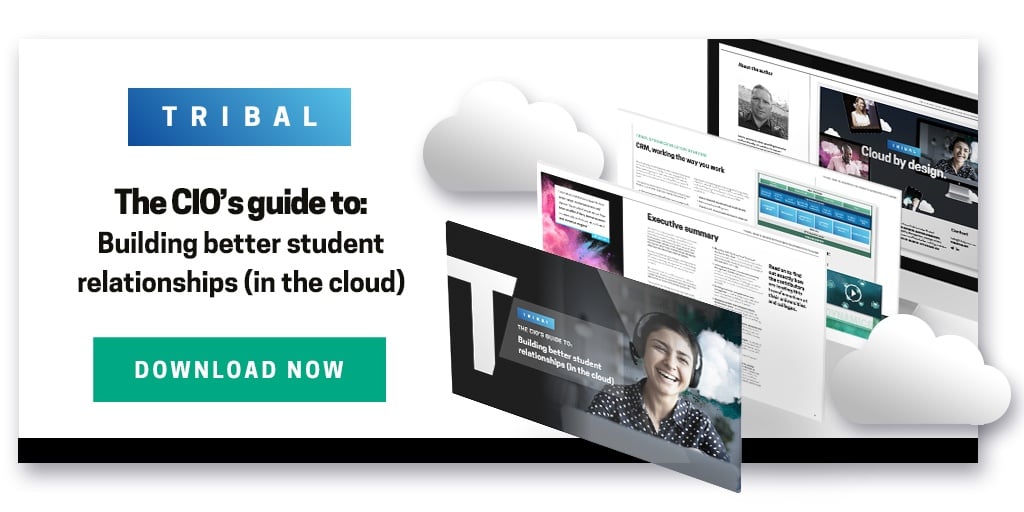Cloud technology in education
More than a third of UK universities have chosen to move to the cloud to date; a more impressive rate than any other type of public body. Clearly higher education institutions are well on their way to digitally transforming their operations, but there’s still work to be done. In a policy paper published by the Department for Education earlier this year, the government recommended that “all education providers actively consider and evaluate the benefits of moving to a cloud-based approach for their IT system”.
Speaking to the UK education sector’s IT leaders who have designed technology and cloud strategies to meet recruitment challenges head on by continuously improving the student experience - we asked these adopters what they set out to achieve, where they are to date on their cloud journeys, and their plans for the coming months and years.
Using this information and their lessons learned we’ve formulated their top tips for other CIOs who want to enable the building of better relationships with students, as well as alumni, businesses, internal academic and administrative teams, and other organisations that contribute to the sustainable running of their institutions.
Speak to others and take the first step:
My recommendation would be to talk to other institutions to understand how they’ve gone at it. Find a comparable reference site for your university or college.”
Gareth McAleese, Head of Enterprise Applications and Data, Ulster University
“My advice? Dive into it, if you can. If you’re serious about recruitment and marketing, use CRM – and use it in the cloud. Particularly if you are in a cash rich university, with a monolithic campus. But expect to spend big. You’ll then reap the rewards. Just remember the business change element of any IT implementation.”
Peter Ashton, CIO, Liverpool John Moores University (LJMU)
Before you start – examine your strategy:
It’s important to realise that you can’t just pick up on-premise solutions and move them to the cloud.”
Tiger Wang, Head of Digital Applications and Portfolios, Kingston University
“Remember tech is an enabler, you’ll need to understand and adapt your business processes around it. Use the migration to the cloud to revisit your process and service, and make them better…”
Gareth McAleese (Ulster University)
“Before you initiate any project to migrate a solution to the cloud – get all your ducks in a row around data security, and issue Cloud Security Assessments as a standard part of your technology consideration process. If the cloud solution provider can’t meet the security criteria – don’t move forward. It’s the same with data privacy.”
Paul Dewhurst, CIO, Blackpool and The Fylde College
“Key to any successful cloud deployment, is a good digital strategy, based on the university’s business strategy. Spend time demonstrating to the executive team how tech can help and how to best invest in IT.”
Peter Ashton (LJMU)
Robust data integration will be vital to your success:
Key to making cloud work for CRM is ensuring all your applications are fully integrated and based on the same data site. This really is fundamental to the strength of your deployment.”
Tiger Wang (Kingston University)“Not having versatile data management capability can be a big barrier to the success of any cloud solution. The more services you migrate, the more you need a data integration strategy that simplifies the way your solutions talk to each other and ensure your cloud implementations are robust. This is the way to ensure you have the highest quality data, and the most useful analytics and insights.”
Gareth McAleese (Ulster University)
Work with Partners to get a cost-effective head start:
“We implemented our CRM with the support of a partner, and made minor developments ourselves.”
Gareth McAleese (Ulster University)
“We’ve been working closely (with our agent) to utilise their product knowledge of (our CRM) – particularly around recruitment and pre-application support, implementing an agent portal, and integrating a third party product to facilitate event management.”
John Hemingway, CIO, Durham University
Gradually open up the potential of the platform:
“There is a lot of useful functionality in (our CRM), Dynamics 365, but if you surface the functionality too quickly - it will overwhelm people. Don’t deploy it all at once with a ‘big bang’. Gradually open up the potential of this platform in a safe way.”
John Hemmingway (Durham University)
“(Our CRM) is module based, so you can take an agile approach, deploying it piece-by-piece, and gaining user buy-in along the way. With each deployment, build on the success of the departments that have gone before. Make the solution really work for each business unit or department, and they will want to own it, and self-support it.”
Tiger Wang (Kingston University)
Post go-live, focus on continuous improvement:
Just remember that when you go live, the job isn’t done. It’s simply the first phase milestone. For example, soon after go-live we had a mandatory Microsoft upgrade project to manage, plus the changes and ideas that have happened since go-live to implement, to improve applicant experience. The improvement cycle shouldn’t stop.”
John Hemmingway (Durham University)
To learn more from these IT leaders as you shape your own digital transformation, read our ‘CIO guide to: Building better student relationships - in the cloud’.
TOPICS:
SHARE THIS ARTICLE:



